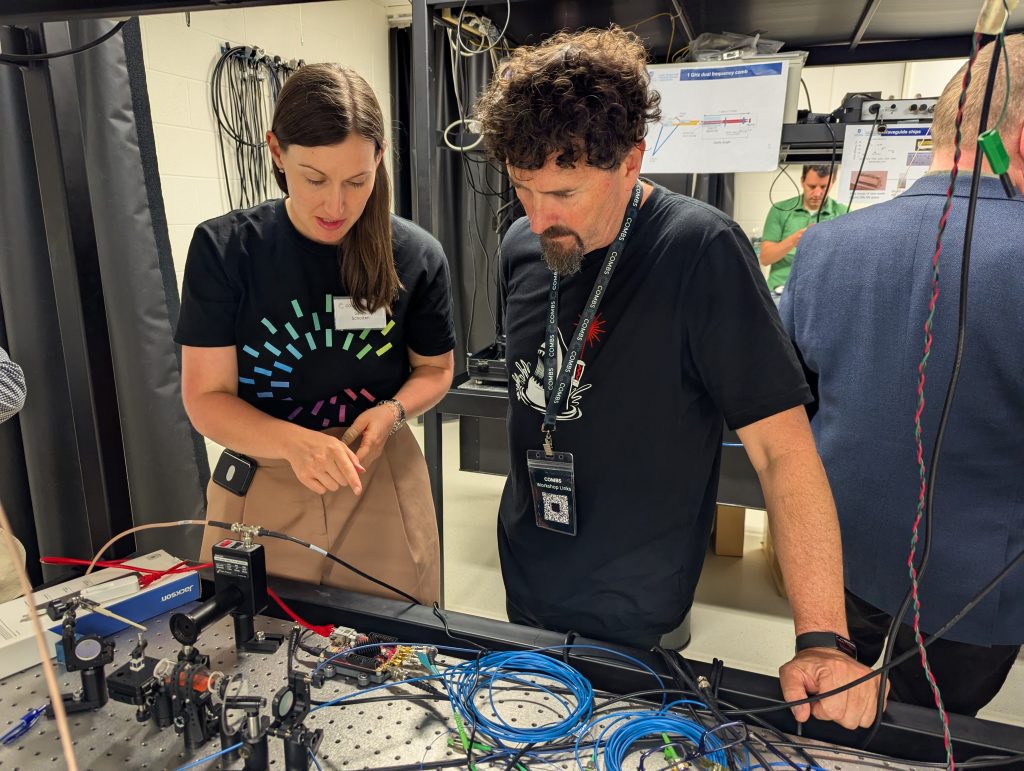Microcomb Science and Technology
Grand challenge
How can we transform the world’s most accurate measurement tool – the optical frequency comb – from a complex and large optical system requiring regular expert maintenance, into a robust, compact and fully automatic integrated circuit that can be manufactured at the scale and cost of today’s consumer electronics?
Background
In 2010, our research team pioneered the first optical frequency combs that could be mass manufactured as cheaply as consumer electronics – we called these microcombs.
While these show extraordinary potential, they still require significant laboratory infrastructure and so there is much work to be done to realise an entire frequency comb system integrated on a single chip.
There also remain fundamental questions about the nature of optical frequency combs – the nonlinear physics that occurs within the chips and we will learn more about how ‘start’ and maintain the comb efficiently and robustly.
This theme will be guided by the needs of the other applications in our Centre – spanning precision measurement, data processing and astronomy – to guide the next generation of microcomb technology.
What do we currently use microcombs for?
Commercial comb systems are emerging incorporating photonic chip technology, but currently these have a similar size and cost to their traditional fibre optic counterparts and so are limited to a few high-end laboratory-based applications such as optical atomic clocks or precision spectroscopy of gases.
If fully integrated microcomb systems could be mass manufactured the same way as today’s consumer electronics they would be precise, robust, compact and affordable enough to be practically used in a vast array of end user applications.
This will get the optical frequency comb out of the laboratory and into the real world with the potential for transformative impacts across society – spanning astronomy, spectroscopy, microscopy, precision measurement, information processing and beyond.
The challenge
Current optical frequency combs are:
- too large; at the size of a laboratory bench
- too expensive; at around $1M AUD
- too complex and fragile to be used in practical applications
Current photonic chip microcombs are:
- Still reliant on laboratory equipment (not ready for complete system integration)
- Limited to the infrared wavelengths used for telecommunications and not capable of operating at the visible, ultraviolet and mid-infrared wavelengths, required for astronomy, biomedical imaging and gas sensing
- Still poorly understood and difficult to achieve the stable ‘comb’ state
Our vision
The vision of our theme is to be able to realise a complete optical frequency comb system on a single chip that can be manufactured with the size, scale and cost of consumer electronics.
These will be robust, efficient, precise, and self-starting, operating at wavelengths tailored to enable breakthroughs across diverse fields.
There are seven key technical challenges the team needs to overcome to achieve this integration:
- Technology to generate the comb (to overcome the need for large lab-tethered equipment)
- Technology to manipulate the comb (to allow for a comb that can be easily adapted to its applications’ needs)
- Microcombs across the spectrum (to allow for a broader range of wavelengths; ie. Getting on the same wavelength as astronomy, biomedical imaging and gas sensing).
How does our team fit into the broader Centre?
Our team is exploring the fundamental science and the technological opportunities of microcombs as the foundational capability of the COMBS centre. We work with each of the other research themes, particularly to design microcombs that can address their technical challenges in their respective applications.
Our team works closely with:
- Information and Intelligence: To understand and develop microcombs that can help to integrate lab-bench components onto a chip the size of a fingernail
- Spectroscopy and Microscopy: To extend the microcomb into the visible and mid-infrared wavelengths needed for biomedical imaging and gas sensing.
- Sensing and Measurement: To create microcombs that can be easily deployed in the field helping spacecraft and submarines navigate, helping autonomous cars to ‘see’ the world around them and monitoring earthquakes.
- Astrocombs: To create a microcomb that is robust and self-starting enough to withstand a decade in the field without needing manual fixing, to enable the search for earth-like planets.













